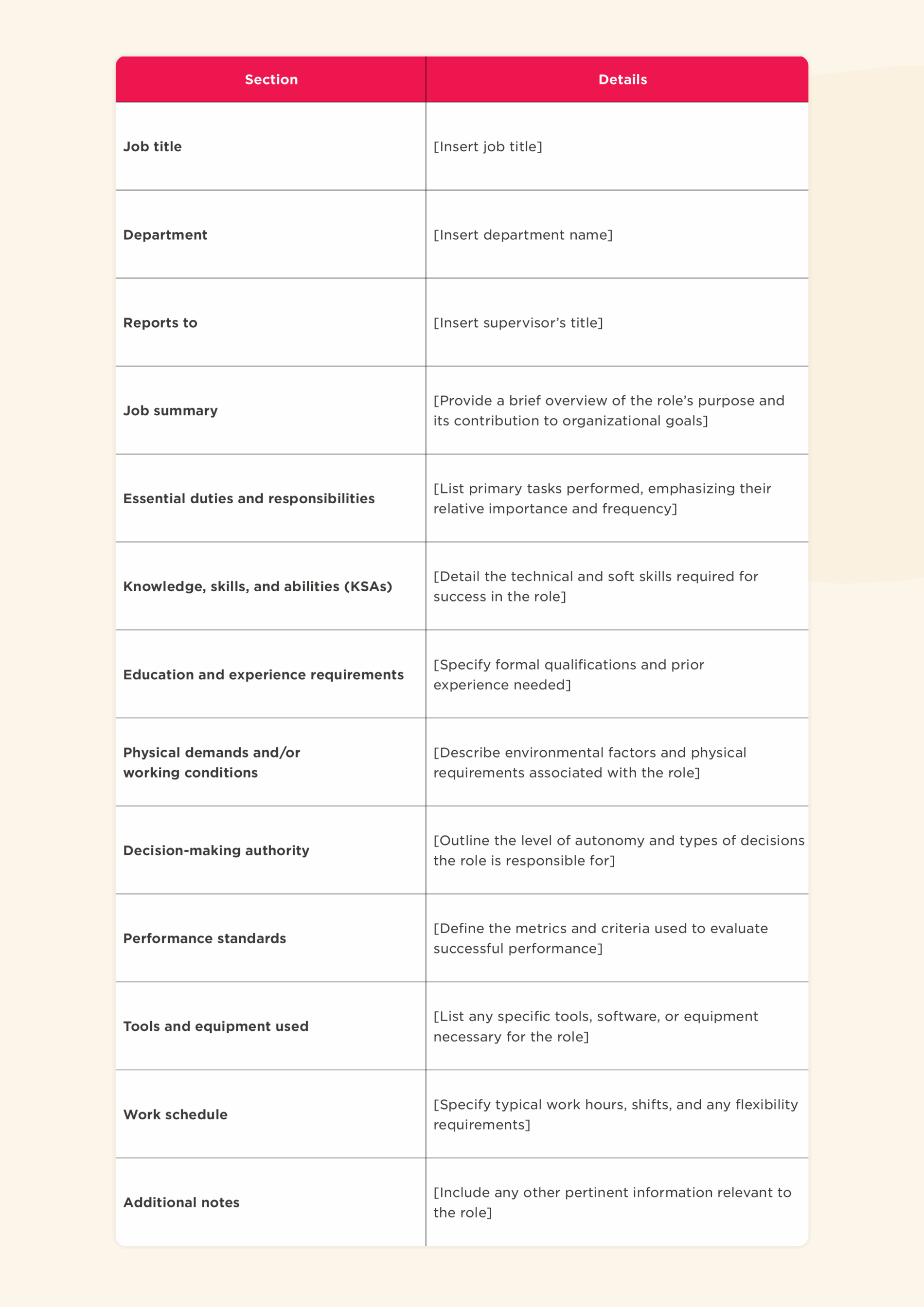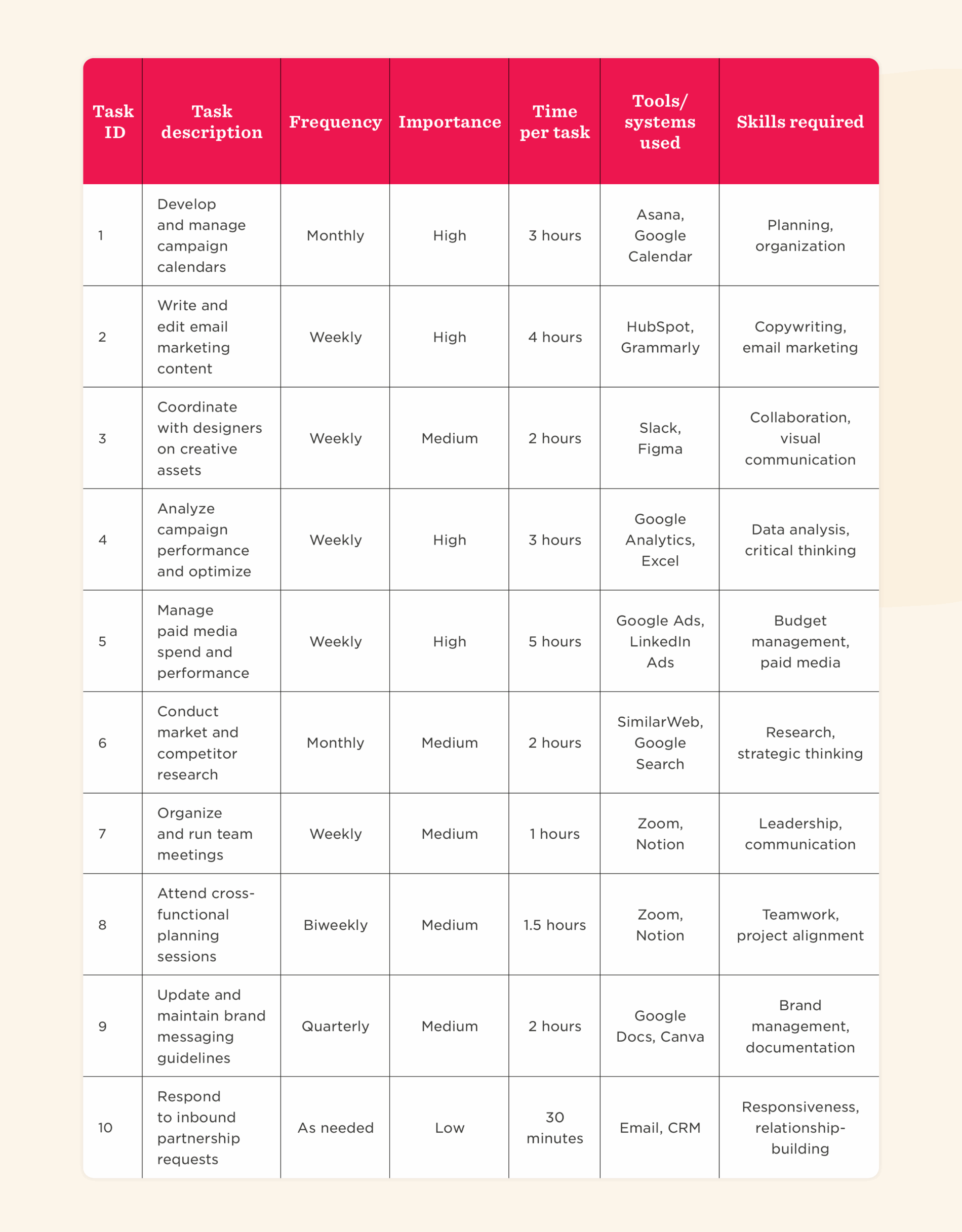Think of job analysis as the blueprint for each position in your organization—it provides structure, clarity, and clear expectations. Job analysis templates help you quickly and consistently define roles, making hiring easier, performance reviews fairer, and career growth transparent.
In this comprehensive guide, we’ll explain exactly how to create meaningful job analyses with a helpful job analysis template.
<<Download our free job analysis template to streamline your HR processes.>>
Why is proper job analysis important?
Job analysis lays the foundation for effective HR management by providing a clear, detailed understanding of each role within your organization. This systematic process documents job duties, responsibilities, and requirements, creating an objective basis for all people-related decisions.
The impact of proper job analysis extends throughout the employee lifecycle:
- Recruitment optimization: Creates accurate job descriptions that attract qualified candidates and set clear expectations
- Compliance: Establishes legally defensible job requirements that minimize discrimination risks
- Performance management: Defines clear metrics for evaluating people’s contributions
- Compensation planning: Provides objective data for creating fair and competitive pay structures
Free job analysis template
Our comprehensive job analysis template provides a structured framework for documenting all essential aspects of a position. The template is designed to be both thorough and flexible, allowing you to capture detailed information while adapting to the unique needs of different roles and departments.
The template includes these key sections:
- Job identification information: Title, department, and reporting relationships
- Job summary and purpose: Brief overview of the role’s contribution to organizational goals
- Essential duties and responsibilities: Primary tasks performed and their relative importance
- Knowledge, skills, and abilities: Technical and soft skills required for success
- Education and experience requirements: Formal qualifications and prior experience needed
- Physical demands and working conditions: Environmental factors, physical requirements, and travel requirements
- Decision-making authority: Level of autonomy and types of decisions made
- Performance standards: Metrics used to evaluate successful performance
- Tools and equipment used: Software, hardware, or machinery required to perform job duties effectively
- Work schedule: Expected hours, shift structure, flexibility, and any on-call requirements
- Additional notes: Space for unique role-specific details not captured elsewhere, such as cross-functional collaboration or role evolution

<<Download our comprehensive job analysis template>>
Bonus: Task inventory template
A task inventory template is a tool that helps document specific activities associated with a role, evaluate their frequency and importance, and identify necessary skills or tools. It’s especially useful for identifying core responsibilities and aligning them with performance expectations. A task inventory includes the following information:
- Task ID: Unique identifier for tracking and reference
- Task description: Concise summary of the activity or duty
- Frequency: How often the task is performed
- Importance: Subjective assessment of how critical the task is to role success
- Estimate time per task: Average time spent on the task per instance
- Tools/systems used: Software, platforms, or physical tools required
- Skills required: Core competencies or knowledge areas needed
Here’s a task inventory template you can use to support structured job analysis:

How to conduct a job analysis
Conducting a job analysis involves collecting data through various methods, analyzing the findings, and documenting the results in a structured format. Following a methodical approach ensures you capture accurate, relevant information that supports strategic HR decisions.
1. Identify the purpose of the job analysis
Begin by clearly defining why you’re conducting the job analysis and how you’ll use the results. This influences which information you’ll need to collect and which methods will be most effective. Common objectives include:
- Creating job postings: Develop job descriptions that accurately reflect role requirements and attract qualified candidates
- Establishing compensation: Set fair pay structures based on responsibilities, skills, and market rates
- Identifying training needs: Pinpoint specific skills gaps that can be addressed through targeted development
- Supporting performance management: Create clear metrics and expectations for evaluating contributions
- Restructuring roles: Identify opportunities to improve operational efficiency through role redesign
2. Choose your data collection methods
Select the most appropriate methods for gathering job information based on the position’s complexity and your organizational context. Each approach offers unique advantages and potential limitations, so consider combining multiple methods for a comprehensive analysis.
| Method | Best for | Limitations |
| Interviews | Gathering detailed insights on complex roles | Time-intensive; subject to individual bias |
| Questionnaires | Collecting data from multiple job holders efficiently | May lack depth; dependent on question quality |
| Direct observation | Understanding practical job execution and workflow | Time-consuming; may alter natural behavior |
| Work logs | Capturing time allocation and task frequency | Relies on accurate self-reporting |
| Critical incident technique | Identifying crucial success factors and challenges | May overemphasize unusual situations |
| Existing documentation | Reference current job descriptions, SOPs (standard operating procedures), project briefs, and performance evaluations | May not be up to date |
3. Gather and analyze the job data
Use your job analysis template to systematically collect and organize relevant data about each role. Focus your data collection on:
- Essential tasks: Daily activities that form the core responsibilities of the role
- Required skills: Technical and soft skills needed for successful performance
- Physical demands: Environmental factors and physical requirements of the position
- Decision authority: Level of autonomy and types of decisions made in the role
- Reporting structure: Supervisory responsibilities and organizational positioning
- Success metrics: Clear indicators used to evaluate performance in the role
- Task inventory data: A detailed breakdown of individual tasks that professionals in the role regularly perform
4. Document your findings
Transform the collected information into a structured, accessible document that supports HR decision-making. Maintain consistent terminology, formatting, and detail across all job analyses to allow easy comparison among roles and departments.
Clearly documented findings become foundational references for future human resources efforts.
<< Use these HR report templates to present your findings.>>
Job analysis examples
The following examples illustrate how to break down two distinct positions using a consistent, detailed format. These samples can guide your own job analysis process and serve as templates when building out role documentation.
HR manager job analysis example
Job title: HR manager
Department: Human resources
Reports to: VP of People and Culture
Job summary: Leads HR processes and initiatives to support organizational goals by managing recruitment, onboarding, talent development, and compliance.
Essential duties and responsibilities:
- Oversee recruitment and onboarding to attract and retain top talent
- Develop and implement HR policies aligned with company culture
- Lead performance management and employee relations processes
- Ensure compliance with employment laws and regulations
Knowledge, skills, and abilities (KSAs):
- Strong knowledge of employment law and HR best practices
- Excellent interpersonal and communication skills
- Skilled in HRIS and employee management software
Education and experience requirements:
- Bachelor’s degree in human resources, business administration, or related field
- Minimum five years of progressive HR experience, including supervisory roles
Physical demands and working conditions:
- Primarily office-based; prolonged sitting and computer usage
- Occasional travel for conferences or team visits
Decision-making authority:
- Autonomous decision-making regarding HR policies, procedures, and employee relations matters within budget guidelines
Performance standards:
- Employee satisfaction score
- Retention levels
- Time-to-hire and time-to-fill open positions
- Compliance audit results
Tools and equipment used:
- HR software
- Learning management systems
- Microsoft Office Suite
- Communication tools
Work schedule:
- Regular office hours (e.g., 9 am–5 pm)
- Occasional flexibility for meetings and events outside standard hours
Additional notes:
- Emphasizes maintaining confidentiality and supporting positive team member relations
- Collaborates closely with department heads to align HR initiatives with company strategy
- Plays a key role in change management and organizational development efforts
Software developer job analysis example
Job title: Software developer
Department: Technology
Reports to: Software development manager
Job summary: Designs, develops, and maintains software applications that enhance business operations and customer experience
Essential duties and responsibilities:
- Write clean, efficient, and maintainable code
- Collaborate with cross-functional teams to define software requirements
- Test and debug software applications
- Provide technical support for existing systems
Knowledge, skills, and abilities (KSAs):
- Proficiency in languages such as Python, Java, or JavaScript
- Familiarity with Agile methodologies and tools (JIRA, Git)
- Strong analytical and problem-solving skills
Education and experience requirements:
- Bachelor’s degree in Computer Science or equivalent experience
- Minimum 3 years of software development experience
Physical demands and working conditions:
- Office-based or remote; extensive computer use.
- Occasional overtime to meet project deadlines.
Decision-making authority:
- Decisions related to technical implementation within defined specifications and guidelines.
Performance standards:
- Code quality metrics (error rates, code reviews)
- Timeliness in project delivery
- Customer and stakeholder satisfaction scores
Tools and equipment used:
- Programming IDEs
- Version control tools
- Project management platforms
Work schedule:
- Typical schedule (9 am–5 pm) with flexible options available
- Occasional overtime during project deadlines
Additional notes
- Focus on continuous learning to stay current with emerging technologies and best practices
- Encouraged to participate in peer code reviews and internal knowledge-sharing sessions
- May contribute to open-source or internal innovation projects
Task inventory example
Here’s an example task inventory for a marketing manager role.

Streamline your HR processes with job analysis templates
A job analysis template is a practical tool that transforms theoretical HR concepts into actionable insights. It creates a common language for discussing position requirements and expectations, facilitating more effective communication between HR, managers, and team members.
Beyond immediate HR applications, job analysis contributes to long-term organizational development by supporting:
- Growth initiatives: Identifies skill gaps that inform training and development initiatives
- Succession planning: Clarifies role requirements for internal advancement opportunities
- Organizational design: Facilitates restructuring based on comprehensive position information
- Compliance support: Provides documentation that supports regulatory requirements
The time invested in thorough analysis pays dividends through improved hiring decisions, more effective performance management, and stronger alignment between individual roles and organizational objectives.
<<Download the free job analysis template. >>
Job analysis template FAQ
What is a job description vs a job analysis?
A job analysis is a systematic approach to understanding and documenting the core responsibilities, required skills, and contextual demands of a position. It helps HR teams gather data through observations, interviews, questionnaires, and other methods to identify what the role truly entails.
A job description is the end product of this analysis, providing a formal, concise summary that outlines the duties, qualifications, and expectations associated with a specific position. While the analysis is exploratory and detailed, the description is targeted and designed for practical use in hiring, onboarding, and performance management.
What are the key components of job analysis?
Key components include essential tasks, required knowledge and skills, physical demands, working conditions, decision-making authority, and performance standards.
Recommended For Further Reading
Can job analysis help with legal compliance in hiring?
Yes. Conducting a job analysis can significantly enhance legal compliance, particularly in recruitment and selection. Grounding hiring criteria in job-related data helps organizations create defensible, transparent foundations for employment decisions.
This approach helps ensure compliance with anti-discrimination laws and promotes fairness across all stages of the hiring process. It supports documentation that demonstrates consistency, objectivity, and alignment with legitimate business needs, reducing the risk of unconscious bias and potential legal challenges.
How often should job analyses be updated?
Job analysis review should be part of an annual HR cycle, but updates are essential whenever meaningful changes occur. These include:
- Organizational restructuring: Mergers, acquisitions, or internal shifts can alter reporting lines and responsibilities
- Technological advancements: New systems or tools might change how a role is performed or what skills are needed
- Regulatory updates: Changes in compliance requirements may affect job expectations
- Team or business strategy changes: As goals evolve, roles may need to adapt to support different outcomes

